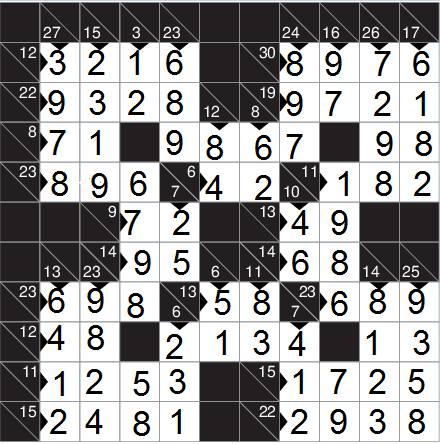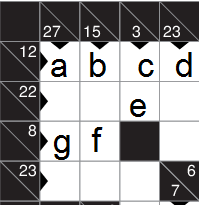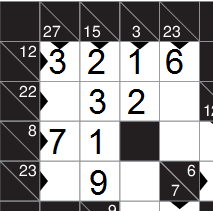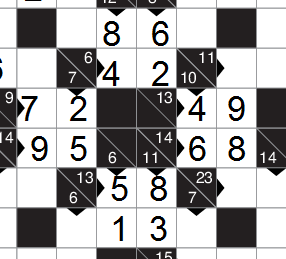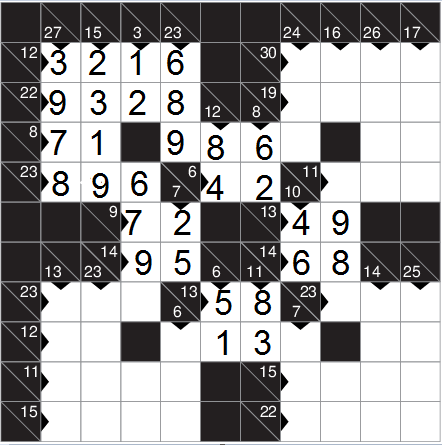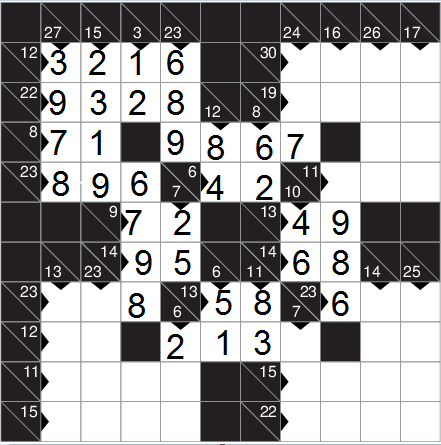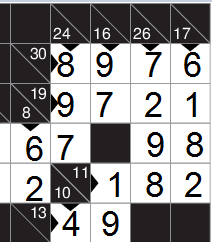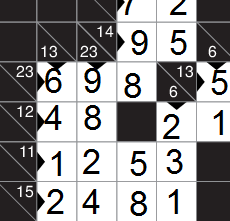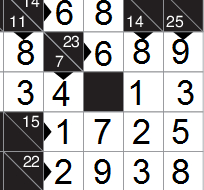The final solution is:
Here are the steps:
First of all, focus on the top-left corner:
Here the only possibility for the vertical 23-run is9 8 6. But 9 or 8 in d would render the 12-run unsolvable, so d=6. Then a+b+c=6, so they are 1,2,3 in some order. But there's no possible combination for 27 with 1 or 2, so a=3. Then the 27-run must be3 7 8 9in some order; but g can't be 9 or 8, so g=7, f=1; so b$\ne$1$\implies $b=2,c=1,e=2. Since the horizontal 23-run is9 8 6, and we need 12 more for the 15-run, the only possibilities for the rest of the 15-run are4 8or3 9. But in the first case, we'd need another 16 for the 22-run, forcing a 7 between a and g, which is bad since g=7. So the part is something like:
Now we'll solve four very similar regions. Focus on this part:
Clearly the only possibilities for the 12-run are7 5or8 4. But the first case would imply d=1, b=7=a, which is bad. So (a,b,c,d)=(8,6,2,4). Similar strategy can be applied to the other 2x2 parts, giving:
Now that we know the 23-run considered in the first paragraph is6 8 9, we can do some usual sum-chasing to arrive at the following:
Now,
we apply some reasoning along the line "
Shas the only combinationa1 a2 a3, but that cell can't havea1ora2, so it'sa3", to arrive at the following:
Next, consider the top-right corner.
The only possibility for the vertical 24-run is
9 8 7in some order, and for 30, it's9 8 7 6in some order. So their intersection must be 9 or 8. If it's 9, then the 16-run must be7 9, and the 24-run would be9 8, which means we need to complete the19run from 8, 9 and 2 more numbers, which is impossible. So the only possibility is:8 9 * *and9 7 * *. Also, since the last two asterisks are1 2in some order, and there's no combination for 4-cell 26-run with a 1, we get that these two rows are8 9 7 6and9 7 2 1. Now some sum-chasing leads to this:
Now let's try the bottom-left corner.
The horizontal 23-run has to be
9 6 8, or6 9 8; but the first possibility would mean we need to get a sum of 4 from 3 cells in the 13-run, so it has to be6 9 8. The other three cells in the 13-run have to be1 2 4in some order. How1or2in that 12 run isn't possible, so the next row is4 8.
Now focus on the remaining 2x4 grid. By summing by rows and then by column, we conclude that the yellow cells must add up to 13; but the only possible combination for the 11-run is1 2 3 5in some order, so these yellow cells must be5 8. Now the remaining cells in the bottom row are1 2 4in some order, and4fits only in the second cell. Now sum chasing yields the following:
To finish things off, look at the bottom right:
it's simple to get that the 23-run is
6 8 9and the 7-run begins with4. Now look at the 22-run. It's first element is1or2and the third element is among1 2 3. So the other two cells must sum up to at least 22-(2+3)=17; but that's the maximum for two cells, so equality holds, and the 22-run is precisely2 9 3 8. Now some quick casework yields the following:
Now it's solved completely!

